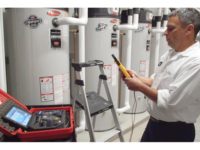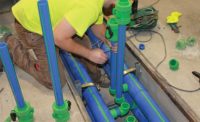It doesn’t take a crystal ball to predict that demand for Air Handling Units (AHUs) for new builds and retrofits will skyrocket over the next decade. Climate change will drive the need for more and more efficient new HVAC systems. HVAC systems in existing buildings will also need upgraded circulation and filtration to cope with post-pandemic air quality standards that are already in the works.
Supply and demand at the intersection of changing market conditions
This all sounds like great news if you are a custom AHU manufacturer. But this demand will strain the ability of AHU manufacturers to respond, because let’s admit it, the way our industry designs, sells and builds AHUs is time-consuming. Up until now, that hasn’t been a huge problem. New construction projects typically move at a pace that doesn’t outstrip AHU production cycles. But that pace will need to accelerate to cope with the sudden spike in demand to upgrade existing structures to current efficiency and public health standards. And that transition is not going to be easy for manufacturers who continue to do business as usual.
The demand drivers
No matter which side of the climate change debate you stand on, developer demand and new legislation will drive the need for new or upgraded AHUs across new builds, retrofits and rehabilitation. Add to that the fact that many jurisdictions are already rewriting their codes to include upgraded filtration, volume control and monitoring for public buildings, and you have two critical vectors pushing demand for new and/or improved AHUs.
In terms of climate change, the role played by cooling technologies is significant. According to a recent report by the UN’s IEA — Environmental Programme: “The growing demand for cooling will increase global warming — from emissions of hydrofluorocarbons (HFCs) used in cooling equipment, and from CO2 and black carbon emissions from the mostly fossil fuel-based energy currently powering cooling. A transition to climate-friendly and energy-efficient cooling, however, would avoid these emissions and allow an increase in cooling access that would contribute substantially to the Sustainable Development Goals (SDGs).”
The pandemic has also revealed another important variable driving demand for new and upgraded AHUs: Harmful pathogens. In a recent article in The Economist magazine, the explored link between AHUs and risk abatement, and the conclusion was clear. “Applied to a typical American school class of 19 pupils and a teacher, the safe time after an infected individual enters a naturally ventilated classroom is (that is, how long before the risk of infection is unacceptably high) is 72 minutes. This period can, though, be extended in two ways. One is by mechanical ventilation of the room, which increases the safe time to 7.2 hours. The other is by everyone wearing masks. In the absence of mechanical ventilation, mask-wearing increases the safe time to eight hours. But the real benefit comes from combining these approaches. That pushes the safe time up to 80 hours—almost 14 days if a school day is six hours long. Add in intervening weekends and a class wearing masks in a schoolroom with adequate ventilation would thereby be safe for longer than the time it takes to recover from Covid-19, which is typically between one and two weeks. School transmissions would thus be rare.”
Yet another recent Economist article explored the cost implications of improved ventilation in schools and public buildings. “The bill for all this need not be huge. A recent study found that raising the standard of ventilation in all American elementary and secondary schools to the minimum level would cost less than 0.1% of the country’s typical public spending on education. President Joe Biden’s American Rescue Plan assigns $123B to improve school infrastructure and mentions ventilation as a priority. Other countries should follow suit.”
Silos are great for grain...
The currently fragmented and siloed processes inside most AHU manufacturers divide sales, design and manufacturing processes. Different teams, using different software, hand off the project to each other at each new phase of the project. This creates inefficiencies, barriers to collaboration and expensive and repetitive rework as data is re-entered into the next teams’ software platforms at each new phase of the project. This rework also introduces a real risk of costly errors creeping into a project due to a simple transposition or data entry error. AHU manufacturers aren’t inefficient or uncompetitive by nature, but the industry hasn’t yet gone through the efficiency-oriented re-engineering that many manufacturing industries have. Silos are great for storing grain, but not so much for efficiency in complex cross-functional team environments.
Digital transformation — workflow is the key
Across almost all industries, digital transformation is driving a new wave of re-engineering. The key to this re-engineering in many industries is the use of unifying platforms to optimize workflow, improve collaboration, and eliminate the inefficiencies that hold back productivity.
In his seminal article “The Digital Transformation: Staying Competitive,” in IT Professional way back in 2014, Seth Earley hits the nail on the head: “Today’s information technologies accelerate the speed at which enterprises make decisions, process information and collaborate to solve problems, but do they provide a competitive advantage? Only if the organization transforms how it does business – using the same old approaches with new software isn't sufficient.”
In a recent article in Automation World, David Greenfield wrote, “Amid all the interest in the digital transformation of the manufacturing and processing industries, most discussions tend to focus on data and analytics. These factors are, of course, integral to the industry’s digital transformation, but ultimately, the analysis of manufacturing operations data is about delivering visibility. Having visibility into production assets and using that info to drive improvements is the key to modern manufacturing—and business, in general, these days.”
In both cases, the authors come to the same conclusion: The main positive impact that digital transformation can have is to enable improved processes. The greatest gains in the custom AHU industry are to be had by unifying the fragmented processes and platforms used to design, sell, manufacture and support our products. We need a new generation of collaborative platforms that allow internal teams, external sales specialists and even clients working from anywhere in the world to come together and manage the entire lifecycle of an AHU from a single pane of glass.
Collaboration = agility = efficiency
With the coming of an unprecedented wave of demand for custom AHUs, those companies who have completed their digital transformation and have implemented unified, collaborative workflows will be in pole position to win the race for this new business. The improvements in capacity and efficiency will mean that organizations that have optimized their workflows will be able to answer RFPs faster and put their designs into production more smoothly. Ultimately, these more agile organizations will be able to deliver more AHUs to their customers more quickly.



